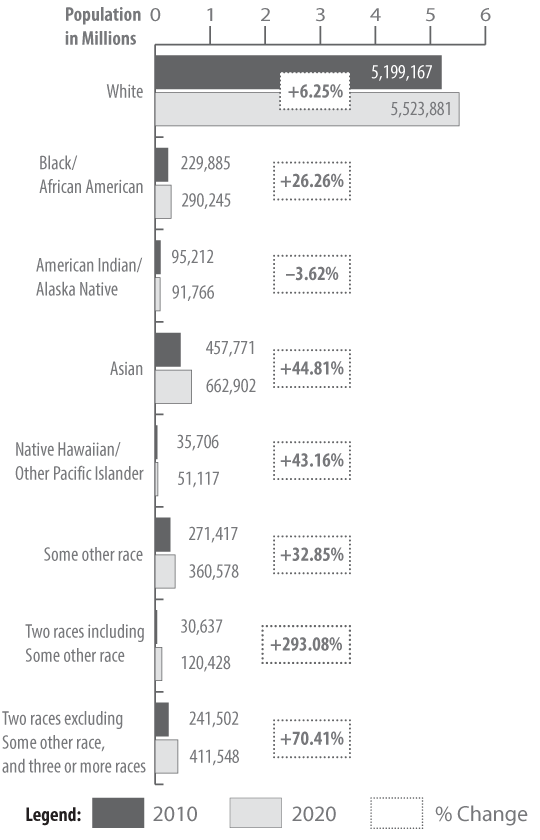IV. Background: Why? How? So What?
Why? The legislature established the Office of Equity because:
1. They found that the diversity of Washington’s population has increased over the last several decades.
Change in race and ethnicity of Washington residents from 2010 to 2020
Source: U.S. Census Bureau American Community Survey, 2010 and 2020 5-year Estimates Detailed Tables, last accessed 12/22/2022.
The graph below compares the Washington State population of eight racial groups between 2010 and 2020.
The population of people who identify as:
- White alone increased from 5,199,167 in 2010 to 5,523,881 in 2020, an increase of 6.25 percent.
- Black or African American alone increased from 229,885 in 2010 to 290,245 in 2020, an increase of 26.26 percent.
- American Indian/Alaska Native alone decreased from 95,212 in 2010 to 91,766 in 2020, a decrease of 3.62 percent.
- Asian alone increased from 457,771 in 2010 to 662,902 in 2020, an increase of 44.81 percent.
- Native Hawaiian/Other Pacific Islander alone increased from 35,706 in 2010 to 51,117 in 2020,
an increase of 43.16 percent. - Some other race alone increased from 271,417 in 2010 to 360,578 in 2020, an increase of 32.85 percent.
- Two races including Some other race increased from 30,637 in 2010 to 120,428 in 2020, an increase of 293.08 percent.
- Two races excluding Some other race, and three or more races increased from 241,502 in 2010 to 411,548 in 2020, an increase of 70.41 percent.
2. As the demographics of our state change, they found that:
1. People from historically and currently marginalized groups still do not have the same opportunities to experience health, wealth, and well-being as their nonmarginalized counterparts.
2. Inequities based on race, ethnicity, gender, and other characteristics continue to be deep, pervasive, and persistent, and they come at a great economic and
social cost.
3. Work happening in agencies to address the disparate outcomes faced by people from historically and currently marginalized groups is fragmented across state government.
How? Listening and learning
Between May and September 2021, state agencies and the Office of Equity conducted baseline equity organizational readiness assessments and listened to thousands of community members and state employees to better understand their priorities for the state’s first five-year equity strategic plan, designed to bridge opportunity gaps and reduce disparities, including racial and ethnic disparities, statewide and across state government. You can view the data dashboards that present the results from these efforts in the Online Toolkit (coming soon).
What we heard from community members and state employees
The following is a collection of quotes from nine different people who responded to the listening surveys. This is a very small sampling of the feedback we received.
“Go to the people. Listen early (before the process is designed or decisions are made) rather than late and listen often. We need to get this right.”
“Explore sustainability from a community perspective: how to build learning structures and culture.”
“Do not create splitting, pitting, or divisive environments for people impacted by inequities.”
“Agencies need to understand differences in cultural values when co-creating with communities.”
“Hire staff who look like communities served and ensure that they are at the decision-making table.”
“Build trust and relationship by hiring people from impacted communities.”
“Set truth and reconciliation tables to lay a solid foundation of trust to own harm and begin healing.”
“Intentionally make time to hear the stories from the community about the harm caused by government and own the pain caused.”
“Take the time necessary to be relational instead of rushing this in the transaction of work.”
So What?
We incorporated all of this input to collaboratively create Washington’s Pro-Equity Anti-Racism (PEAR) Ecosystem Plan & Playbook, a statewide strategy that calls for state agencies and communities to work together to achieve equity and justice statewide and across Washington’s 100+ state-supported agencies.
